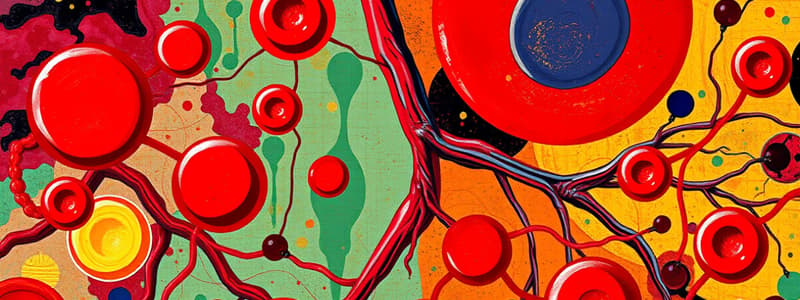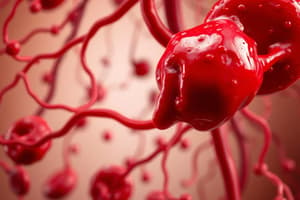Podcast
Questions and Answers
Gamma globulins are a class of plasma proteins called?
Gamma globulins are a class of plasma proteins called?
- Fibrinogen
- Antibodies (correct)
- Albumins
- Clotting proteins
Serum is blood plasma minus its ______.
Serum is blood plasma minus its ______.
clotting proteins
Which of the following is most likely to cause hemolytic anemia?
Which of the following is most likely to cause hemolytic anemia?
- Heavy metals
- Bacterial infections
- Mushroom poisoning (correct)
- Viral infections
It is impossible for a type O+ baby to have a type ______ mother.
It is impossible for a type O+ baby to have a type ______ mother.
Which of the following is not a component of homeostasis?
Which of the following is not a component of homeostasis?
Which of the following contributes most to the viscosity of blood?
Which of the following contributes most to the viscosity of blood?
Which of these is a granulocyte?
Which of these is a granulocyte?
Excess iron is stored in the liver as a complex called?
Excess iron is stored in the liver as a complex called?
Pernicious anemia is a result of?
Pernicious anemia is a result of?
The first clotting factor that the intrinsic and extrinsic pathways have in common is?
The first clotting factor that the intrinsic and extrinsic pathways have in common is?
Production of all the formed elements of blood is called?
Production of all the formed elements of blood is called?
The percentage of whole blood volume composed of RBCs is called the?
The percentage of whole blood volume composed of RBCs is called the?
The extrinsic pathway of coagulation is activated by _______ from damaged perivascular tissues.
The extrinsic pathway of coagulation is activated by _______ from damaged perivascular tissues.
The RBC antigens that determine transfusion compatibility are called ______.
The RBC antigens that determine transfusion compatibility are called ______.
The hereditary lack of factor VIII causes a disease called _______.
The hereditary lack of factor VIII causes a disease called _______.
The overall cessation of bleeding, involving several mechanisms, is called ___________.
The overall cessation of bleeding, involving several mechanisms, is called ___________.
__________ results from a mutation that changes one amino acid in the hemoglobin molecule.
__________ results from a mutation that changes one amino acid in the hemoglobin molecule.
An excessively high RBC count is called _________.
An excessively high RBC count is called _________.
Intrinsic factor enables the small intestine to absorb ______.
Intrinsic factor enables the small intestine to absorb ______.
The kidney hormone __________ stimulates RBC production.
The kidney hormone __________ stimulates RBC production.
Study Notes
Blood Components and Functions
- Gamma globulins: Class of plasma proteins that function as antibodies, essential for immune response.
- Clotting proteins: Serum is blood plasma without clotting proteins, crucial for hemostasis.
- Erythrocytes: Red blood cells are pivotal for blood viscosity, impacting circulation and oxygen transport.
- Ferritin: A complex in the liver that stores excess iron, vital for preventing iron deficiency.
Blood Disorders and Conditions
- Hemolytic anemia: Can be caused by mushroom poisoning, highlighting toxic impacts on red blood cells.
- Pernicious anemia: Results from a lack of intrinsic factor, necessary for vitamin B12 absorption.
- Hemophilia: A hereditary condition caused by the lack of clotting factor VIII, leading to increased bleeding risk.
- Sickle cell disease: A genetic mutation alters one amino acid in hemoglobin, causing misshaped red blood cells and related health issues.
- Polycythemia: Refers to an excessive rise in red blood cell count, which can lead to complications like increased blood viscosity.
Hemostasis and Coagulation
- Thromboplastin: Activates the extrinsic pathway of coagulation in response to blood vessel damage.
- Factor X: The clotting factor common to both intrinsic and extrinsic pathways, playing a key role in the coagulation cascade.
- Hemostasis: Overall process to stop bleeding, involving vascular spasm, platelet plug formation, and coagulation.
Blood Types and Compatibility
- Agglutination: Not part of homeostasis; a reaction that can occur in incompatible blood transfusions.
- Agglutinogens: RBC antigens that determine blood type and transfusion compatibility, crucial for safe transfusions.
- Type O+ parent: A type O+ baby cannot have an AB- mother, reflecting genetic inheritance patterns.
Blood Production and Measurement
- Hemopoiesis: The process of producing all formed elements in the blood, including red blood cells, white blood cells, and platelets.
- Hematocrit: Measurement of the percentage of whole blood volume made up of red blood cells, indicating red blood cell concentration.
- Erythropoietin: A hormone released by the kidneys that stimulates the production of red blood cells, crucial in response to low oxygen levels.
Nutritional Aspects
- Vitamin B12: Critical for proper red blood cell formation, its absorption requires intrinsic factor.
Studying That Suits You
Use AI to generate personalized quizzes and flashcards to suit your learning preferences.
Description
Test your knowledge on the circulatory system with these flashcards focusing on blood components. Learn about gamma globulins, clotting proteins, and more as you explore key definitions and concepts. Perfect for students studying human biology and anatomy.




